|
|
Peugeot 508
|
 |
|
|
Debut: 2011
Maker: Peugeot
Predecessor:
407
|
|
|
|
Published
on 2
Feb 2011
|
All rights reserved.
|
|
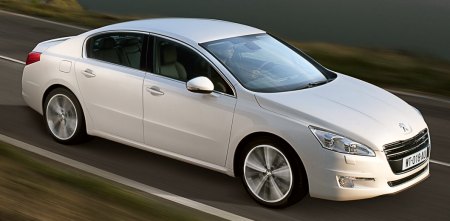
I
am lucky to be old enough to remember the glorious days of French
large cars. However, those days have long gone. No matter how hard Vel
Satis, 607 and C6 tried, demand for French large cars simply dried up.
Blame the German domination, the Japanese invasion and the change of
market trend. Worse still, this trend is spreading towards the class
below. Peugeot used to be very successful with its mid-size line of 405
and 406. Not so the 407. Just three years into the market, it sales
slid to 130,000 units. By 2009, it fell further to a miserable 40,000
units. The message is clear: it needs to be changed.
The new
508 is
the logical result of the above development. It takes up
the vacancies left by both 407 and 607, so hopefully it will have more
space for survival. Naturally, the 508 is sized between 407 and 607,
but made with much better quality to make it possible to serve as a
junior executive car. Compare with 407, it is 12 cm longer, 4 cm wider,
1 cm taller and runs a 9 cm longer wheelbase. This enables as much as
53 mm more rear seat legroom than its predecessor, answering our
biggest criticism on the 407. Compare with 607, the 508 is 8 cm
shorter, but slightly wider and marginally longer in wheelbase. As a
result, its cabin serves four six-footers
comfortably.
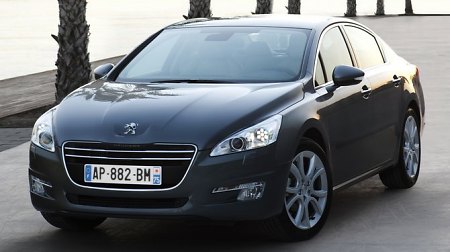
The 508 is built on the
same platform as sister car Citroen C5. Compare with the outgoing 407,
it is
easily more aerodynamic. On the cars fitted with skinniest tires,
drag coefficient has been reduced from the previous 0.29 to a
class-leading 0.25. Another notable improvement is weight control –
an area we used to criticize the 407. Engine by engine, the new
car is an average 35 kg lighter than 407, according to Peugeot. And
this is not just claims. Read our old 407 report from the link at the
top of this page, you will see the 508 is really lighter in most cases.
Considering the new car is so much bigger and better built, this is an
admirable achievement.
To fulfill the job as a junior executive car, the 508 has to up its
game in NVH suppression. And it did. Peugeot fitted it with
noise-absorbing acoustic windscreen, hydro-elastic suspension mounts
and, in the case of most powerful 2.2HDi model, active engine mounts.
This explain why the car delivers superb refinement on the road, as we
shall see.
Regarding driving dynamics, I am pleased to see it keeps the 407's
electro-hydraulic power steering, even though switching to a pure
electrical rack would have saved more money and boosted fuel economy by
a couple of percentage. No wonder the 508 delivers excellent steering
feel. Finally someone puts driving fun on top priority !
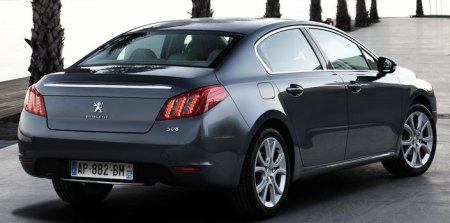
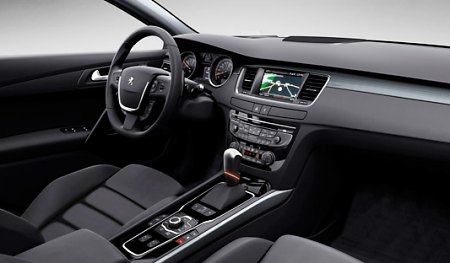
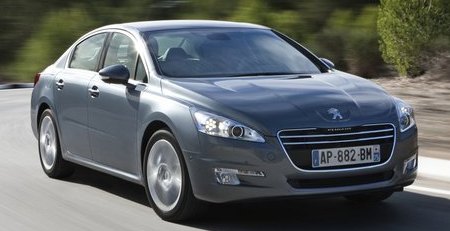
Unlike the interior, I am not so sure about the exterior design.
Peugeot new
design boss Gilles Vidal promised an adventurous styling theme on the
SR1 concept coupe shown a year ago. However, the production 508 looks
less convincing. Its proportion is somewhat wrong – doesn't its bonnet
look too high ? and the ground clearance under its front overhang look
as large as those on SUVs ? Many other designers found ways to overcome
the
negative effect of pedestrian safety law by means of visual tricks.
Unfortunately, Peugeot just failed to do that on the 508. Not just
this, I have problems to appreciate its new corporate grille, whose
black plastic elements do not gel with the chrome elements. The
"PEUGEOT" wording at the nose and the pronounced section of the bonnet
cut away a piece of the chrome surround. The effect is quite busy and
strange. Zoom out, the whole car looks remarkably close to some recent
Nissan / Infiniti designs. Should you mask its front grille, I suppose
many people would fail to recognize it.
However, styling aside, the new Peugeot has few things to complain. It
is well built, comfortable and refined to spend your time in. Depending
on front suspensions, you will get either decent or great handling, and
on all versions a communicative steering is guaranteed. With the
introduction of 508, the border between mainstream and premium brand
executive cars has never been so mushy.
|
Verdict:     |
Published
on 20
Jan 2015
|
All rights reserved.
|
|
508 facelift (2014)
|
|
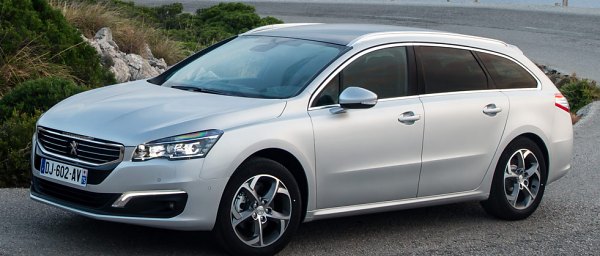
|
The prosperity of
premium-brand saloons is a bad news to mainstream-brand ones. Even
though Peugeot has already consolidated its 607 and 407 into a single
508, its sales keep declining. There is no way PSA can resist the
trend. Although big French saloons carried a long history and the love
of many fans, a smart businessman like Carlos Tavares, PSA’s new CEO,
would not hesitate to cut the line and concentrate resources on the
more profitable hatchbacks and crossovers. If he has spare money to
play with large cars again, he would rather invest into the premium DS
brand. This means, the bloodline of Peugeot big cars is unlikely to
live beyond 508.
However, before that happens, the 508 is updated once more. Launched in
mid-2014, this mid-life facelift should carry 508 through its destiny.
It has the nose heavily restyled – now more upright and squarer. The
front grille gets slimmer and more angular. The bonnet gets flatter,
and the lion logo is moved to the center of front grille. The new nose
appears to be more upmarket, especially with LED daytime running lights
and LED headlamps (the latter is standard on top models). It is
definitely smarter than the old design. Unfortunately, the fat
proportion of the old car is unaltered.
For a non-premium saloon, the 508 is still renowned for quality
finishing. Its cabin is generally made of high-quality materials and is
tightly screwed together. The interior still looks up-to-date, if not
as advanced as 308. Moreover, this cabin is spacious, allowing 3 adults
to sit comfortably at the back.
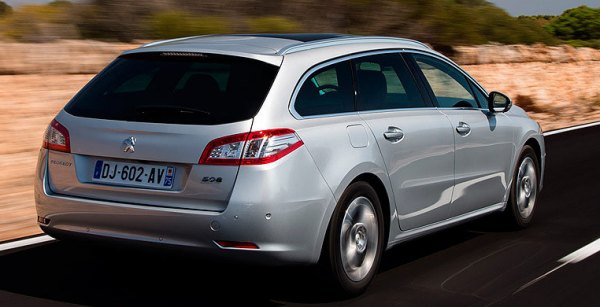
|
The range-topping GT model with 2.2 HDi engine is still our
pick of the range, thanks to the better handling and ride achieved by
its double-wishbone front suspension. Unfortunately, it is as expensive
as some BMW 3-Series and Audi A4s, so by far the majority of sales goes
to lesser models fitted with MacPherson struts up front. The latter are
nowhere as good to drive, showing average roadholding, precision, ride
comfort and refinement. They fail to match Ford Mondeo or new
Volkswagen Passat in just about any dynamic aspects.
Most of the popular engines have been improved in this facelift. The
1.6 THP direct injection turbo is benefited with an extra 9 hp,
bringing the total to 165 hp. Through optimized gearing, ECU and
addition of automatic stop-start, its rated emission is reduced by 10
percent. Similarly, diesel engines get more power yet lower
consumption. The 140 hp 2.0 HDi is improved to 150 hp, while 163 hp
version is upgraded to 180 hp. The numbers are competitive, but none of
them can match the equivalent motors of BMW and Audi in terms of
low-end response and high-end refinement. The big Peugeot is left to an
embarrassing position: while its styling and build quality target at
premium D-segment cars, it is not as well-engineered as those rivals.
Neither is it cheap enough to lure buyers from a class below. The
facelift did little to change this situation.
|
Verdict:    |
|
|
|
|
|
|
|
|
|
|
508
1.6THP
|
2011
|
| Front-engined,
FWD |
| Steel monocoque |
| Mainly steel |
| 4792 / 1853 / 1456 mm |
| 2817 mm |
Inline-4
|
| 1598 cc |
DOHC 16 valves, VVT
|
| Turbo |
| DI |
| 156 hp |
| 177 lbft |
| 6-speed manual |
F: strut
R: multi-link
|
| - |
| 215/55R17 |
1400 kg
|
| 138 mph (c) |
8.1 (c)
|
| - |
|
508
2.0HDi
|
2011
|
| Front-engined,
FWD |
| Steel monocoque |
| Mainly steel |
| 4792 / 1853 / 1456 mm |
| 2817 mm |
Inline-4, diesel
|
| 1997 cc |
DOHC 16 valves
|
| VTG turbo |
| CDI |
| 163 hp |
| 251 lbft |
| 6-speed automatic |
F: strut
R: multi-link
|
| - |
| 215/55R17 |
1520 kg
|
| 140 mph (c) |
8.7 (c)
|
| - |
|
508 GT 2.2HDi
|
2011
|
| Front-engined,
FWD |
| Steel monocoque |
| Mainly steel |
| 4792 / 1853 / 1456 mm |
| 2817 mm |
Inline-4, diesel
|
| 2179 cc |
DOHC 16 valves
|
| VTG turbo |
| CDI |
| 204 hp |
| 332 lbft |
| 6-speed automatic |
F: double-wishbones
R: multi-link
|
| - |
| 235/45R18 |
1540 kg
|
| 145 mph (c) |
7.7 (c)
|
| - |
|
|
|
|
|
Performance
tested by: -
|
|
|
|
|
|
|
508 1.6THP
|
2014
|
| Front-engined,
FWD |
| Steel monocoque |
| Mainly steel |
| 4830 / 1828 / 1456 mm |
| 2817 mm |
Inline-4
|
| 1598 cc |
DOHC 16 valves, VVT
|
| Turbo |
| DI |
| 165 hp |
| 177 lbft |
| 6-speed manual |
F: strut
R: multi-link
|
| - |
| 215/55R17 |
1400 kg
|
| 130 mph (c) |
8.1 (c)
|
| - |
|
508 2.0HDi 180
|
2014
|
| Front-engined,
FWD |
| Steel monocoque |
| Mainly steel |
| 4830 / 1828 / 1456 mm |
| 2817 mm |
Inline-4, diesel
|
| 1997 cc |
DOHC 16 valves
|
| VTG turbo |
| CDI |
| 180 hp |
| 295 lbft |
| 6-speed automatic |
F: strut
R: multi-link
|
| - |
| 235/45R18 |
1540 kg
|
| 140 mph (c) |
8.0 (c)
|
| - |
|
|
|
|
|
|
| Performance
tested by: - |
|
|
|
|
|
|
|
|
Copyright©
1997-2015
by Mark Wan @ AutoZine
|
|